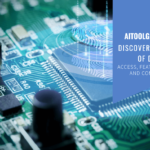ChatGPT is a super-smart AI chatbot created by OpenAI. It’s like having a brainy buddy who can chat about almost anything!
This cool tech uses something called GPT (Generative Pre-trained Transformer) to understand and respond to questions in a human-like way.OpenAI launched ChatGPT on November 30, 2022, and boy, did it take off!
In just two months, it snagged over 100 million users, making it the fastest-growing consumer app ever. That’s faster than TikTok or Instagram! ChatGPT can do all sorts of neat tricks. It can write stories, answer questions, and even help with homework.
It’s so good at chatting that some folks worry it might replace human jobs or make it too easy to cheat on tests. As ChatGPT keeps getting smarter, more and more people are using it every day. It’s changing how we think about AI and what computers can do!
Technical Foundation of ChatGPT
ChatGPT’s brain is built on some pretty cool tech stuff. Let’s break it down!First up, we’ve got the Large Language Model (LLM) architecture. Think of it like a super-smart word machine.
It’s learned from tons of text on the internet, so it can understand and write like a human. The LLM is the big boss behind ChatGPT’s smarts.
Now, let’s talk about the GPT series. GPT stands for Generative Pre-trained Transformer. It’s like a family of smart robots, and each new version gets even smarter.
We started with GPT-1 back in 2018, and now we’re up to GPT-4! These models keep getting bigger and better at understanding language.
The training process for ChatGPT is like sending it to a mega school for computers. It reads billions of words from the internet, books, and articles.
One of its main textbooks is called Common Crawl, which is like a giant snapshot of the web. The model learns patterns and rules about language by predicting what word comes next in a sentence.
It’s like playing a super-advanced word guessing game!ChatGPT uses a special Transformer architecture, which is a fancy way of saying it can pay attention to different parts of a sentence at the same time.
This helps it understand context better than older AI models.The training data is huge! We’re talking about hundreds of billions of words.
To put that in perspective, if you tried to read all that text out loud, it would take you over 500 years! And the model itself? It’s got a whopping 175 billion parameters or little knobs it can adjust to get better at language.
All this training helps ChatGPT become a language whiz. It can write stories, answer questions, and even help with homework.
But remember, it’s not perfect. Sometimes it might say things that sound right but aren’t actually true. That’s why it’s always good to double-check important stuff!
Key Features and Capabilities OF ChatGPT
ChatGPT has some pretty cool tricks up its sleeve! Let’s dive into its key features and what it can do.First off, ChatGPT is a whiz at natural language processing and generation.
It’s like having a super-smart pen pal who can write just like a human. This AI buddy can understand and create text in over 26 languages! It’s so good that some companies using ChatGPT have saved a whopping $50,000 to $70,000 in costs.
How cool is that? ChatGPT can even do things like figure out if a sentence is happy or sad, and sum up big chunks of text without breaking a sweat.Next up, let’s talk about ChatGPT’s conversational abilities.
This chatbot isn’t just a one-trick pony – it can keep up a real conversation! It remembers what you said before and can even fix its mistakes if you point them out. It’s like talking to a friend who really listens.
No wonder it’s become so popular – by 2023, a whopping 180.5 million people were using ChatGPT! That’s more than half the population of the United States!But wait, there’s more! ChatGPT is a jack-of-all-trades when it comes to multi-task functionality.
Need help writing a story? ChatGPT’s got your back. Stuck on a tricky math problem? It can help with that too. It can even write and fix computer code! Over 100 million people around the world are using ChatGPT for all sorts of tasks. It’s like having a super-smart helper that can do a little bit of everything.
Last but not least, ChatGPT is really good at understanding context and remembering things in conversations. It’s not just spitting out random facts – it actually gets what you’re talking about.
If you ask a follow-up question, it remembers what you were talking about before. It’s like having a conversation with someone who’s really paying attention.
Some smart folks have even done tests that show ChatGPT can keep up with humans in understanding language in different situations.
Here’s a fun example: Let’s say you’re planning a birthday party. You could ask ChatGPT for ideas for games, then ask about cake recipes, and then ask for decoration tips.
ChatGPT would remember you’re planning a party and keep all its suggestions party-themed. It’s like having a party planner in your pocket!
Or imagine you’re working on a school project about space. You could ask ChatGPT to explain how rockets work, then ask it to help you write a short story about going to Mars, and then ask for help creating a quiz about space facts.
ChatGPT would keep the space theme going through all these different tasks.All these features make ChatGPT a super useful tool for all sorts of things.
Whether you need help with homework, want to brainstorm ideas for a story, or just want to chat about your favorite topics, ChatGPT is there to lend a hand.
It’s changing the way we think about AI and how it can help us in our daily lives.Just remember, as smart as ChatGPT is, it’s still a computer program. It can make mistakes or say things that aren’t true.
So always double-check important information, especially for school or work. But for fun and creative stuff, ChatGPT can be an awesome buddy to have around!
Accessing and Using ChatGPT
Let’s talk about how to get your hands on ChatGPT and use it like a pro!First up, you’ve got two flavors of ChatGPT: the free version and the fancy ChatGPT Plus.
The free one lets you play with GPT-3.5, which is pretty cool. But if you want to level up, you can shell out $20 a month for Plus. That gets you the super-smart GPT-4 and some extra perks.
You can chat with ChatGPT on your computer or your phone. Just head to chat.openai.com or grab the app from your app store. It’s as easy as pie to sign up – just click “Sign up” and follow the steps.Once you’re in, you’ll see a simple chat box.
Type your question or request, hit enter, and boom! ChatGPT starts talking back. You can even upload pictures or use your voice to chat. How cool is that?Here are some pro tips to get the most out of ChatGPT:
Be super clear in your questions. The more details, the better!
Don’t be shy to ask for changes. If you don’t like the answer, just say so.
Try different temperatures (that’s AI lingo for how creative it gets). Low for facts, high for wild ideas!
Use chain prompts to break big tasks into smaller steps.
Applications and Use Cases of ChatGPT
ChatGPT is like a super-smart helper that can do all sorts of cool stuff! Let’s check out some of the awesome ways people are using it.
1. Personal Assistance
ChatGPT is great at helping with everyday tasks. It’s like having a brainy buddy in your pocket!
A. Writing Help
Need help writing? ChatGPT’s got your back! It can help you:
Write emails that sound just right
Create awesome social media posts
Come up with catchy blog ideas
A whopping 58% of businesses use ChatGPT for content writing. That’s a lot of people getting writing help!
B. Research Buddy
ChatGPT is like a super-fast research assistant. It can:
Find info on almost any topic
Summarize long articles
Help you understand tricky subjects
People love using ChatGPT for research. In fact, 27% of teachers use it to get background knowledge for their lessons.
C. Brainstorming Wizard
Stuck on ideas? ChatGPT can help you think outside the box! It’s great for:
Coming up with creative story ideas
Solving tricky problems
Planning fun activities
D. Educational Support
ChatGPT is making waves in schools and colleges. It’s like having a super-smart tutor available 24/7!
E. Homework Helper
ChatGPT can explain tough subjects in simple ways. It can:
Break down complex math problems
Explain tricky science concepts
Help with essay outlines
Kids are catching on fast – 33% of students aged 12-17 say they’ve used ChatGPT for school work.
F. Lesson Planning
Teachers are loving ChatGPT too! It helps them:
Create fun classroom activities (30% of teachers use it for this)
Plan engaging lessons (30% use it here too)
Come up with cool project ideas
In fact, 51% of teachers are already using ChatGPT in some way. That’s a lot of tech-savvy teachers!
G. Language Learning
Want to learn a new language? ChatGPT can:
Practice conversations with you
Explain grammar rules
Teach you new words and phrases
It’s like having a patient language tutor who never gets tired!
2. Applications
ChatGPT isn’t just for fun – it’s helping people at work too!
A. Coding Companion
For computer whizzes, ChatGPT is like a coding buddy. It can:
Help fix buggy code
Explain tricky programming concepts
Even write simple programs
No wonder 66% of businesses use ChatGPT for coding tasks!
B. Content Creation Machine
ChatGPT is a content creator’s dream. It can help:
Write catchy headlines
Create product descriptions
Generate ideas for videos or podcasts
Businesses are loving this feature – 58% use ChatGPT for content creation.
C. Customer Service Superstar
ChatGPT is changing how companies talk to their customers. It can:
Answer common questions
Help solve problems
Give product recommendations
Companies using AI like ChatGPT are seeing customer service get 30-45% better. That’s a lot of happy customers!
3. Creative Endeavors
ChatGPT isn’t just for serious stuff – it can get creative too!
A. Story Writing
Want to write a story? ChatGPT can:
Help you come up with cool characters
Suggest exciting plot twists
Even write short stories with you
It’s like having a writing partner who’s always ready to brainstorm!
B. Music Making
ChatGPT can even help with music! It can:
Write song lyrics
Suggest chord progressions
Come up with fun music video ideas
While it can’t compose full songs yet, it’s still a great tool for musicians to get inspired.
C. Art Inspiration
Artists are using ChatGPT to spark their creativity. It can:
Describe imaginative scenes for paintings
Suggest unique sculpture ideas
Help create digital art concepts
When paired with AI art tools like DALL-E or Midjourney, ChatGPT can even help create amazing visual art.
Real-World Examples
Let’s look at some cool ways people and companies are using ChatGPT:
Koo, a social media platform, uses ChatGPT to help users create better posts and content.
Snapchat has a ChatGPT-powered chatbot called “My AI” that users can talk to.
Instacart is using ChatGPT to help shoppers find the best ingredients for recipes.
Some teachers are using ChatGPT to create personalized study guides for their students.
Job seekers are using ChatGPT to write better resumes and cover letters.
ChatGPT is changing the game in so many areas! From helping kids with homework to making businesses run smoother, this AI buddy is proving super useful.
Limitations and Challenges of ChatGPT
While ChatGPT is super cool, it’s not perfect. Let’s talk about some of its hiccups and challenges.First up, ChatGPT can sometimes get things wrong or make stuff up. It’s like that friend who always has a story, but you’re not sure if it’s true.
For example, it might mix up dates or invent fake facts. This is called hallucination, and it happens because ChatGPT doesn’t really understand what it’s saying – it’s just really good at putting words together.
Next, we’ve got some big ethical worries. ChatGPT can sometimes be biased, spread fake news, or even copy other people’s work without giving credit. It’s like a parrot that repeats everything it hears, good or bad.
Some folks are worried this could make it harder to tell what’s true online.Privacy is another biggie.
ChatGPT needs lots of data to work, and some people worry about where that data comes from and who can see it. It’s like sharing your diary with a robot – you want to make sure it keeps your secrets!
Companies using ChatGPT need to be super careful about keeping user info safe.Lastly, there’s the job thing.
Some people are scared ChatGPT might take their jobs. In fact, 32% of business leaders think ChatGPT might lead to more layoffs in the next 5 years. But it’s not all doom and gloom! While some jobs might change, ChatGPT is also creating new ones.
It’s like when cars were invented – fewer horse-drawn carriage drivers, but more car mechanics!To deal with these challenges, we need to be smart about how we use ChatGPT.
We should always double-check important info, be aware of bias, and keep learning new skills. ChatGPT is a cool tool, but it’s not meant to replace humans – it’s here to help us!
Ongoing Development and Future Prospects
ChatGPT is like a super-smart kid that keeps getting smarter! OpenAI, the company behind ChatGPT, is always working to make it better. They’ve rolled out cool new features like GPT-4o, which can understand pictures and do math like a whiz.
And get this – they’re even teaching ChatGPT to remember stuff from earlier chats!But ChatGPT isn’t just hanging out by itself. It’s making friends with other AI tools too! For example, some folks are using ChatGPT with DALL-E to create awesome pictures.
Imagine telling ChatGPT about a unicorn riding a skateboard, and then DALL-E draws it for you. How cool is that?ChatGPT is changing the way we work and play.
In fact, 49% of companies are already using it, and 30% more plan to jump on board soon. It’s helping people write code, create content, and even provide customer support.
Some worry it might take jobs away, but others think it’ll create new and exciting careers we haven’t even thought of yet!
There’s a whole bunch of other AI chatbots trying to keep up with ChatGPT. Google has Gemini, Microsoft has Copilot, and there’s even one called Claude by a company named Anthropic.
It’s like a race to see who can make the smartest AI buddy!As ChatGPT and its pals keep getting better, who knows what amazing things they’ll be able to do in the future? It’s an exciting time for AI, and we’re all along for the ride!
Conclusion
ChatGPT is a game-changer in the world of AI, offering amazing help with all sorts of tasks. It’s like having a super-smart friend who’s always ready to lend a hand.
From writing and research to coding and customer service, ChatGPT is making waves in how we work and learn. But we need to be smart about using it.
While it’s super helpful, it’s not perfect and can sometimes make mistakes. As AI keeps getting better, it’s exciting to think about what ChatGPT and other AI tools might do in the future. The key is to use ChatGPT responsibly and remember that it’s here to help us, not replace us.
- Guide to Connect Claude AI with Google Sheets in 2024 - October 11, 2024
- What is DreamGF? Honest review by Expert - October 9, 2024
- How to Use Claude AI in 2024? - October 7, 2024






